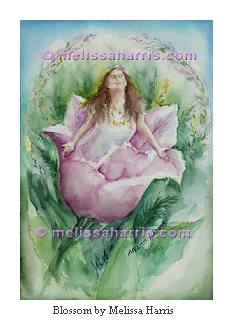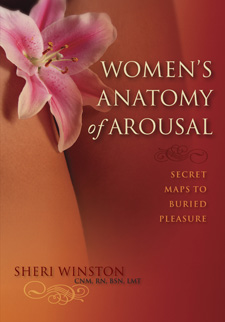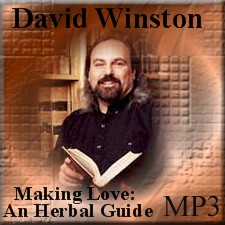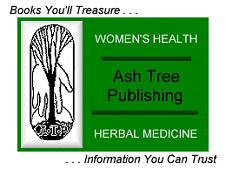Author of Women's Anatomy of Arousal: Secret Maps to Buried Pleasure
Vaginal Ecology is the concept that the vagina is a complex
integrated environment. It involves the study of that environment,
with the goal of understanding that there are inherent safeguards
in place to try to maintain a state of healthy balance. Also,
that the vaginal environment is susceptible to influences
that can alter it's state of balance.
 Through
understanding this system, we can gain control of our vaginas,
keeping them working well by supporting the natural systems.
And when the natural balance is disturbed, resulting in vaginal
imbalance and infection, this information gives us the power
to remedy the situation.
Through
understanding this system, we can gain control of our vaginas,
keeping them working well by supporting the natural systems.
And when the natural balance is disturbed, resulting in vaginal
imbalance and infection, this information gives us the power
to remedy the situation.
When all the factors that influence the vagina are in a state
of balance, the vagina feels good, works well, has a faint,
pleasant odor and a small amount of discharge. When factors
are present that can influence the environs and they cause
a shift, a healthy vagina can compensate for the temporary
imbalance and restore a state of health.
If the vagina is unhealthy or out of balance to start, the
health promoting mechanisms will be overwhelmed, the balance
can't be remedied, and vaginal infections result.
A normal vagina is hot, at core body temperature or very
slightly above. It is moistened by a normal discharge that
is partly from glands in the cervix, partly from the cells
lining the walls and partly from 2 sets of glands. This fluid
doesn't itch, burn or smell bad. It varies in color from clear
to white, depending on where you are in your cycle, if you
are a 'cycling' woman. When it dries it may appear yellowish.
Pre-pubertal girls and post-menopausal woman are drier and
less varying. In women who are having normal fertility cycles
the amount also varies depending on where in your cycle you
are, and ranges from scant to moderate. If there is profuse
discharge, that's usually abnormal and a sign of imbalance
or infection.
 pH
is a complex concept but can be understood simply. It is a
scale with acid on one end and base or alkaline at the other.
Acidic is easy to understand, it is like lemons or vinegar--its
tart. Alkaline is a bit harder to grasp, but think of it as
bland. there is a spectrum in between the two extremes, with
the midpoint being neutral. Numbers are used to describe where
on the scale anything lies. The most acidic is 1, the most
alkaline extreme is at 14. A healthy vagina is a bit acidic
(a little tart, as it were). On the pH scale, it is usually
around 4.0, although the normal range is between 3.5 to 4.5.
pH
is a complex concept but can be understood simply. It is a
scale with acid on one end and base or alkaline at the other.
Acidic is easy to understand, it is like lemons or vinegar--its
tart. Alkaline is a bit harder to grasp, but think of it as
bland. there is a spectrum in between the two extremes, with
the midpoint being neutral. Numbers are used to describe where
on the scale anything lies. The most acidic is 1, the most
alkaline extreme is at 14. A healthy vagina is a bit acidic
(a little tart, as it were). On the pH scale, it is usually
around 4.0, although the normal range is between 3.5 to 4.5.
Normal vaginal discharge contains a small amount of natural
sugars, but not much unless the woman is diabetic or pregnant.
A normal minimal level of sugar helps to discourage yeast
overgrowth, while an increased level promotes it.
Finally, one of the most important factors, that is often
overlooked by medical practitioners, is the presence of healthy
bacteria. These good bacteria, called Lactobacillus acidophilis,
have an important job to do. They keep other microbes from
taking over. The types of lactobacilli that reside in the
vagina produce hydrogen peroxide, which produces oxygen, which
kills certain non-friendly bacteria and yeasts. The friendly
flora hold a place in the vaginal ecosystem, preventing invaders
from taking over, much like having a garden filled with healthy
plants, prevents most weeds from growing.
There are a variety of things that can act to disrupt or
shift the vaginal equilibrium.
Both blood and semen are alkaline and their presence can
provide an environment more likely to nurture hostile bacteria
or yeast. A healthy population of beneficial bacteria can
quickly restore the natural acidity.
 The
vaginal environment also shifts slightly during the course
of the normal female cycle. Just prior to menses, the vagina
is driest and most tender, with a slight shift towards a less
acidic level due to decreased populations of the good bacteria
and other hormonal influences. This is frequently a time when
women are most prone to vaginitis. Also just after the period,
when there is still some blood present is another time when
the environment is more at risk of being shifted out of balance.
The
vaginal environment also shifts slightly during the course
of the normal female cycle. Just prior to menses, the vagina
is driest and most tender, with a slight shift towards a less
acidic level due to decreased populations of the good bacteria
and other hormonal influences. This is frequently a time when
women are most prone to vaginitis. Also just after the period,
when there is still some blood present is another time when
the environment is more at risk of being shifted out of balance.
Douching upsets the vaginal environment in a number of ways.
It shifts the pH, it causes direct irritation and inflammation
of the vaginal mucosa (the delicate lining), and it washes
away the good bacteria. So do not douche. It can also drive
bad bacteria up into the uterus and increase the risk of pelvic
inflammatory disease (PID, infection of the uterus and fallopian
tubes).
Women who douche, even infrequently are much more prone
to the common vaginal infection, Bacterial Vaginosis (BV).
All so-called 'feminine hygiene products' (suppositories,
sprays, cleansers, etc) are useless, potentially disruptive,
totally unnecessary and a waste of your money. Also avoid
any strong chemicals, such as deodorant soaps, anti-bacterial
soaps, strongly perfumed soaps or body washes as they can
all have negative effects on the beneficial flora and lead
to infections and irritation.
Certain forms of contraception can affect the vaginal environment.
Any product that contains Nonoxynol 9, the chemical that is
in all spermicides can be problematic. One woman out of 3
or 4 will be sensitive  to
the chemical and will have inflammation as a result of its
use. This includes condoms with spermicide as well as all
spermicidal creams, jellies and suppositories. Hormonal birth
control methods (birth control pills, the depo shot, Norplant
implants, progesterone-containing IUDs, the ‘Patch’,
the ‘Ring’), all work by tricking your body into
thinking that its already pregnant and therefore doesn't need
to ovulate. So just like in actual pregnancy, there may be
slightly higher amounts of natural sugars in your vaginal
discharge and hormonal shifts in the pH that may promote vaginal
imbalance and infection.
to
the chemical and will have inflammation as a result of its
use. This includes condoms with spermicide as well as all
spermicidal creams, jellies and suppositories. Hormonal birth
control methods (birth control pills, the depo shot, Norplant
implants, progesterone-containing IUDs, the ‘Patch’,
the ‘Ring’), all work by tricking your body into
thinking that its already pregnant and therefore doesn't need
to ovulate. So just like in actual pregnancy, there may be
slightly higher amounts of natural sugars in your vaginal
discharge and hormonal shifts in the pH that may promote vaginal
imbalance and infection.
For post-menopausal women, the vaginal walls tend to become
thinner, there is less vaginal lubrication and the ph may
also shift slightly, making them more prone to imbalance.
Also for those who chose to take hormone 'replacement' therapy,
they may also cause shifts such as mentioned above for hormonal
birth control.
Essentially, the genitalia is a self-regulating, self-cleaning
system and the less you disrupt the natural balance, the better
off you’ll be. When you understand the concept that
an imbalance exists before an infection is fully manifest
you have the power to shift the ecology back into a healthy
direction and prevent most problems.
Sheri Winston, CNM, BSN, RN, LMT
Womancare Practitioner
Teacher Of Womancraft & Wholistic Sexuality
Women’s Health Care Provider, Educator, Midwife, Massage
Therapist


Sheri Winston is a Teacher
of WomanCraft & Wholistic Sexuality, a retired Midwife, a
Womancare Practitioner, Blood Witch and Pelvic Priestess.
She's also a Registered Nurse, Health and Sexuality Educator,
Women's Health Issues Counselor, Licensed Massage Therapist,
Writer and Artist. In over 20 years of working with women's
health, she's attended over 500 births and provided clinical
health care, counseling and education for thousands of women.
Sheri currently offers wholistic gynecological health consultations
and teaches classes and workshops on women's health, female
anatomy, wholistic sexuality and birth.

Women's Anatomy of Arousal:
Secret Maps to Buried Pleasure
 by Sheri Winston
by Sheri Winston
266 pages.
Chock-full of information, illustrations, erotic art, games and exercises, a guided tour, wholistic sexuality, orgasmic abundance ...
The clitoris is just the tip of the volcano. Women have a largely unknown network of structures responsible for arousal and orgasm that even most medical professionals don’t know about. ... This fun, sexy, empowering guide combines lost knowledge with ancient and modern sexuality information to illuminate every woman’s secret paths to fabulous, orgasmically abundant sex.
Price: $19.95
OrderWomen's Anatomy of Arousal in our Bookshop
Making Love: An Herbal Guide - digital download
 MP3 digital download - David Winston. 8th International Herb Symposium 2007. Run time 1:37:21.
MP3 digital download - David Winston. 8th International Herb Symposium 2007. Run time 1:37:21.
Making Love: An Herbal Guide to Sexual Health.
Sex is an integral part of our lives, yet so many people suffer from lack of sexual fulfillment due to physiological and psychological problems...
Price: $19.95
Order Making Love: An Herbal Guide in our Bookshop
Herbs and Sexual Hormones - digital download

MP3 digital download - Matthew Wood - 7th International Herb Symposium 2005. Run time 1:25:03.
A study of the excess and deficiency of estrogen, progesterone, and androgen, the patterns of imbalance they create, their relationship to wider hormonal imbalances, and the herbs that treat them, with a salute to the heritage gift of great women’s remedies received from the Native peoples of America.
Price: $9.95
Order Herbs and Sexual Hormones MP3 in our Bookshop
Sexy Herbs - digital download
 MP3 digital download - Ed Smith. 4th International Herb Symposium 1998. Run time 1:34:52.
MP3 digital download - Ed Smith. 4th International Herb Symposium 1998. Run time 1:34:52.
Class for Everyone: (1.5 hr): In this informative and fun workshop, Ed covers herbal sexual tonics for men and women, aphrodisiacs, sexual stimulants, eroto-enhancers, and the treatment of erotomania, impotence, frigidity, and other such maladies.
Price: $11.95
Order Sexy Herbs (mp3) in our Bookshop

 Through
understanding this system, we can gain control of our vaginas,
keeping them working well by supporting the natural systems.
And when the natural balance is disturbed, resulting in vaginal
imbalance and infection, this information gives us the power
to remedy the situation.
Through
understanding this system, we can gain control of our vaginas,
keeping them working well by supporting the natural systems.
And when the natural balance is disturbed, resulting in vaginal
imbalance and infection, this information gives us the power
to remedy the situation.  pH
is a complex concept but can be understood simply. It is a
scale with acid on one end and base or alkaline at the other.
Acidic is easy to understand, it is like lemons or vinegar--its
tart. Alkaline is a bit harder to grasp, but think of it as
bland. there is a spectrum in between the two extremes, with
the midpoint being neutral. Numbers are used to describe where
on the scale anything lies. The most acidic is 1, the most
alkaline extreme is at 14. A healthy vagina is a bit acidic
(a little tart, as it were). On the pH scale, it is usually
around 4.0, although the normal range is between 3.5 to 4.5.
pH
is a complex concept but can be understood simply. It is a
scale with acid on one end and base or alkaline at the other.
Acidic is easy to understand, it is like lemons or vinegar--its
tart. Alkaline is a bit harder to grasp, but think of it as
bland. there is a spectrum in between the two extremes, with
the midpoint being neutral. Numbers are used to describe where
on the scale anything lies. The most acidic is 1, the most
alkaline extreme is at 14. A healthy vagina is a bit acidic
(a little tart, as it were). On the pH scale, it is usually
around 4.0, although the normal range is between 3.5 to 4.5. The
vaginal environment also shifts slightly during the course
of the normal female cycle. Just prior to menses, the vagina
is driest and most tender, with a slight shift towards a less
acidic level due to decreased populations of the good bacteria
and other hormonal influences. This is frequently a time when
women are most prone to vaginitis. Also just after the period,
when there is still some blood present is another time when
the environment is more at risk of being shifted out of balance.
The
vaginal environment also shifts slightly during the course
of the normal female cycle. Just prior to menses, the vagina
is driest and most tender, with a slight shift towards a less
acidic level due to decreased populations of the good bacteria
and other hormonal influences. This is frequently a time when
women are most prone to vaginitis. Also just after the period,
when there is still some blood present is another time when
the environment is more at risk of being shifted out of balance.
 to
the chemical and will have inflammation as a result of its
use. This includes condoms with spermicide as well as all
spermicidal creams, jellies and suppositories. Hormonal birth
control methods (birth control pills, the depo shot, Norplant
implants, progesterone-containing IUDs, the ‘Patch’,
the ‘Ring’), all work by tricking your body into
thinking that its already pregnant and therefore doesn't need
to ovulate. So just like in actual pregnancy, there may be
slightly higher amounts of natural sugars in your vaginal
discharge and hormonal shifts in the pH that may promote vaginal
imbalance and infection.
to
the chemical and will have inflammation as a result of its
use. This includes condoms with spermicide as well as all
spermicidal creams, jellies and suppositories. Hormonal birth
control methods (birth control pills, the depo shot, Norplant
implants, progesterone-containing IUDs, the ‘Patch’,
the ‘Ring’), all work by tricking your body into
thinking that its already pregnant and therefore doesn't need
to ovulate. So just like in actual pregnancy, there may be
slightly higher amounts of natural sugars in your vaginal
discharge and hormonal shifts in the pH that may promote vaginal
imbalance and infection.

 MP3 digital download - David Winston. 8th International Herb Symposium 2007. Run time 1:37:21.
MP3 digital download - David Winston. 8th International Herb Symposium 2007. Run time 1:37:21.


